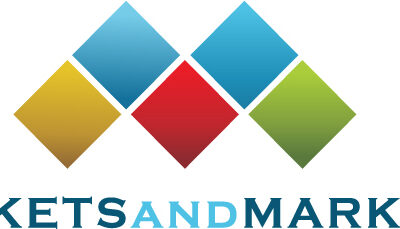Tech
L’ottimismo crittografico nell’era del cataclisma

Rebecca Rettig
Collaboratore
Rebecca Rettig è il responsabile legale e politico di Polygon Labs, dove supervisiona tutte le questioni politiche globali e incontra regolarmente politici e regolatori di tutto il mondo. Con una competenza unica e radicata nel rappresentare aziende in prima linea nella trasformazione digitale del settore dei servizi finanziari, Rebecca ha trascorso oltre quattro anni fornendo consulenza ai clienti blockchain su questioni legali e normative. Nel 2019, Rebecca è stata riconosciuta come una delle 100 migliori avvocatesse di New York.
Lo scorso inverno mi sono ritrovato a una cena in città. Era un pubblico misto, con questo intendo le persone che capivano il mio lavoro, quelle che non lo capivano o quelle che erano scettiche nei suoi confronti. Sono un avvocato specializzato in criptovalute e sostenitore delle politiche, quindi sono abituato a domande del tipo: sei un avvocato per Bitcoin? E usi anche una banca?
Come tutti sappiamo, il settore delle criptovalute è stato scosso alla fine del 2022, il che significa che ho risposto a più domande del solito. A un certo punto, un amico mi prese da parte e mi chiese: “È questa la fine delle criptovalute? Stai bene?”
Ora, un anno dopo, posso rispondere con sicurezza: non solo non è stata la fine, ma il 2023 è stato anche un anno positivo per le criptovalute. Sono più impegnato che mai in questo ambito e, nel 2024, sono certo che la tecnologia persisterà, che le criptovalute sono qui per restare, anche a dispetto della ripetuta stampa negativa, dei continui oppositori e della persistente pressione normativa globale. .
La tesi dell’ottimista riguardo alle criptovalute è semplice: la maturità tecnica si sta verificando di pari passo con i progressi normativi e l’adozione più ampia.
Ma essere ottimisti nel settore delle criptovalute significa in realtà essere realisti, riconoscere non solo gli entusiasmanti sviluppi che vediamo entrare nel 2024, ma anche le sfide che dobbiamo affrontare frontalmente nell’anno a venire. Io chiamo questo approccio “realismo cripto-ottimista”: un riconoscimento sia di quanta strada abbiamo fatto sia di quanta strada dobbiamo percorrere.
Anche se il 2023 ha superato le aspettative degli ottimisti come me, ciò non significa che il 2024 sarà un gioco da ragazzi. In effetti, nelle tre questioni che contano di più per le criptovalute – progresso tecnico, progresso normativo e adozione – i venti favorevoli che ci porteranno al 2024 si scontreranno con continui ostacoli che dobbiamo superare per progredire verso un settore maturo.
La tecnologia è avanzata più velocemente di quanto chiunque immaginasse. Ora dobbiamo mostrare perché questo è importante.
Sulla scia dei crolli finanziari centralizzati “crypto-in-only”, il 2023 ha confermato un rinnovato impegno a far avanzare reti sostenibili, rafforzate e decentralizzate. La tecnologia, attraverso reti diverse, sta finalmente raggiungendo un livello in grado di gestire abilmente ciò che le “norme” si aspetterebbero da Internet stesso, sia che si tratti di applicazioni finanziarie, sociali, di comunicazione/messaggistica o informative.
L’anno scorso, il settore era ossessionato dalla tecnologia a conoscenza zero, da zkEVM e dalle soluzioni di scalabilità, giustamente. Enormi progressi tecnologici si sono concretizzati su vasta scala, sfidando le aspettative di molti che credevano che se tale tecnologia fosse stata possibile al di fuori dei teoremi matematici, non sarebbe stata possibile per decenni.
Ora esistono modi più veloci, più convenienti e più efficienti per effettuare transazioni e interagire su Internet, protetti da database decentralizzati ospitati su computer a livello globale che consentono agli individui di preservare e controllare i propri dati, valore e contenuti. Lo stato attuale della blockchain sembra decisamente uscito da “Neuromante”.
Ma eccoci qui, a viverlo.
Ora la sfida è garantire che anche milioni di persone in tutto il mondo possano vivere questo futuro.
Il primo abisso da superare è come parlare in modo accessibile di cosa fanno effettivamente le blockchain e perché sono migliori, almeno per alcuni casi d’uso, rispetto a ciò che abbiamo ora. L’uso di termini interni (“rollup”, “contratti intelligenti”, “oracoli”) con il mondo tradizionale è spesso controproducente. Il gergo rende la tecnologia e l’industria esoteriche, isolazioniste e inaccessibili. Gran parte del lessico associato alla blockchain è stato sviluppato per un pubblico ristretto di sviluppatori, il che significa che per crescere insieme alla portata in espansione della tecnologia, dobbiamo cambiare anche il modo in cui ne parliamo.
Con alcune sfide tecnologiche in procinto di essere risolte su larga scala, resta l’ostacolo principale per comprendere meglio il perché della blockchain.
Ciò significa spiegare come la tecnologia offra vantaggi reali e tangibili in un modo facilmente comprensibile su base globale e tra tecnici, norme e settori.
La “chiarezza normativa” ha fatto progressi in modi inaspettati, ma le sabbie mobili dell’AML richiedono una soluzione
Per quelli di noi impegnati in questioni politiche, la fine del 2022 è stata esistenziale. Era difficile capire come i regolatori e i politici potessero impegnarsi in modo significativo dopo che il settore in generale era stato tappezzato di problemi di integrità derivanti dal crollo di aziende che non devono essere nominate (e che ormai conosci bene). Con mia grande sorpresa, l’anno scorso abbiamo visto un impegno significativo da parte dei politici di tutto il mondo sulle questioni relative alle criptovalute, in molti modi positivi che non avrei potuto prevedere. A livello globale, il 2023 ha visto:
- I legislatori giapponesi hanno pubblicato ad aprile il whitepaper “Cool Japan”. Ha proposto una legge per le organizzazioni autonome decentralizzate (DAO, un’altra parola per renderle accessibili!) come modalità per consentire alle città e alle comunità meno connesse di impegnarsi con il governo e aprirsi alle stablecoin non sostenute dallo yen (con una rigorosa regolamentazione sulle stablecoin).
- L’UE ha formalmente approvato e iniziato ad attuare il regolamento sui mercati delle criptovalute (MiCA). MiCA, una legislazione completa unica nel suo genere incentrata sulle imprese centralizzate e sui fornitori di servizi nel settore delle criptovalute, stabilisce requisiti rigorosi per le imprese crittografiche nell’UE, consentendo allo stesso tempo una continua innovazione dal punto di vista tecnologico.
- Il Dipartimento del Tesoro del Regno Unito ha presentato una proposta completa per la regolamentazione delle criptovalute.
- In Francia, i politici hanno cominciato a rifletterci quadri per la finanza decentralizzata (DeFi), prendendo la tecnologia abbastanza sul serio da prendere in considerazione normative che non soffochino l’innovazione, proteggendo allo stesso tempo i consumatori e preservando l’integrità del mercato.
- Hong Kong e gli Emirati Arabi Uniti hanno creato regimi di licenza crittografica per imprese e fornitori di servizi di criptovaluta centralizzati, incluso, a Hong Kong, un nuovo regime proposto per l’emissione di stablecoin.
- Negli Stati Uniti, due importanti atti legislativi proposti, il Financial Innovation and Technology for the 21st Century Act (Legge FIT) e il Chiarezza per la legge sulle stablecoin di pagamento, sono usciti dal Comitato per i servizi finanziari della Camera in modo bipartisan, con potenziali preparativi per passare alla Camera nel 2024. E lo scorso giugno, il Comitato per l’energia e il commercio della Camera degli Stati Uniti ha condotto un’importante audizione sull’argomento casi d’uso non finanziari per blockchain. Questa è stata una dimostrazione diretta del fatto che i politici stanno iniziando a comprendere l’ampia portata di ciò che può essere realizzato utilizzando la blockchain.
Parallelamente, i progressi sulla politica crittografica negli Stati Uniti sono arrivati anche da decisioni sperate ma inaspettate da parte dei tribunali.
Numerosi giudici federali – nominati dai presidenti di entrambi i partiti – hanno mostrato una particolare comprensione delle sfumature e delle differenze presentate dalla tecnologia e dal modo in cui funziona l’industria. IL Ondulazione, Scala di grigi e tutti i tribunali di Uniswap hanno riconosciuto gran parte delle argomentazioni sulla decentralizzazione e sull’autocustodia che l’industria porta avanti da anni. In tal modo, questi tribunali hanno dimostrato che le posizioni di alcuni regolatori cercano davvero di inserire il piolo quadrato delle criptovalute nel buco rotondo di TradFi, con risultati limitati.
La decisione nel caso Risley v. Uniswap Labs et al. è particolarmente degno di nota per due motivi. Innanzitutto, la decisione approfondisce la tecnologia della finanza decentralizzata. Riconosce che gli sviluppatori di software che innovano con nuove tecnologie non possono essere responsabili per le azioni di terzi sconosciuti e non affiliati che potrebbero impegnarsi in “cattive azioni” tramite il software (un corollario alle decisioni di Napster e Grokster più di due decenni fa). In secondo luogo, la decisione ha riconosciuto che non sappiamo cosa siano le criptovalute in questo momento: “titoli, materie prime o qualcos’altro”. Fare questa distinzione è una decisione di competenza del Congresso. Quest’ultimo riconoscimento è degno di nota anche dal momento che il caso della SEC contro Coinbase, che dipende in gran parte dal fatto che “i token siano titoli”, è davanti allo stesso tribunale.
Nonostante questi progressi, il settore non ha la “chiarezza normativa” che chiedeva. In effetti, la sfida per il 2024 è più grande che mai: come possiamo collaborare con i regolatori e i politici a livello globale per combattere i malintenzionati che utilizzano le criptovalute per scopi illeciti? Questa domanda, generalmente definita questione AML (antiriciclaggio), è cruciale affinché le criptovalute non solo prosperino, ma anche sopravvivano.
Il modo in cui l’industria può e dovrebbe affrontare la questione dell’antiriciclaggio richiede un proprio articolo (o più articoli!), ma la nostra sfida sul fronte normativo è chiara. L’industria deve unirsi per fornire soluzioni praticabili che rispondano agli obiettivi normativi di individuazione e deterrenza dei malintenzionati.
Oggi abbondano casi d’uso più ampi, ma dobbiamo renderli più utili
Non sorprende che io soprannomini il 2023 “l’anno del caso d’uso”. È stato un anno in cui ho contribuito a lanciare un sito web aperto e interattivo, La proposta di valore (thevalueprop.io), per mostrare casi d’uso della tecnologia blockchain in tutto il mondo. Questo sito aggrega nuove applicazioni basate su blockchain già esistenti.
Pensa agli avatar su Reddit, alle scarpe digitali su Nike o ai programmi fedeltà NFT con Starbucks. Pensa ai grandi marchi che sperimentano come lasciare andare il controllo totale sui programmi fedeltà e sui punti, abbandonandoli invece alla custodia e alla proprietà degli utenti. Il DMV della California ha esaminato tokenizzazione dei titoli automobilistici; ci sono esperimenti con il putting registrazione catastale on-chain nel Perù; e dintorni metà degli stati indiani hanno iniziato a incorporarsi in diversi servizi, inclusi denunce della polizia.
Pensa alla tokenizzazione degli asset off-chain nel settore finanziario e oltre, dove JPMorgan, Franklin Templeton, BNY Mellon, Mirae Asset Securities e molti altri hanno già iniziato a tokenizzare gli asset, con alcune stime portando il numero totale di asset tokenizzati già a 3 miliardi di dollari. Progetti come Courtyard e Regen Network consentono la tokenizzazione di risorse come carte Pokémon e crediti di carbonio.
Mentre il primo gruppo consentirà al nostro attuale sistema finanziario di muoversi in modo più rapido ed efficiente, il secondo trasformerà chi può partecipare all’economia, e come.
In quasi tutti i verticali che puoi immaginare, alcuni elementi della blockchain hanno iniziato ad apparire.
Sebbene sempre più persone interagiscano ogni giorno con alcuni aspetti di alcune blockchain, molte senza nemmeno saperlo, la sfida ora è concentrare l’industria sui casi d’uso che sono quelli di maggiore impatto e che cambiano maggiormente le regole del gioco. I costruttori devono continuare a costruire, ma in modi che abbiano un forte fascino. Ciò significa andare oltre la narrazione di lunga data di “mettere in banca coloro che non hanno banche”, che, nel bene e nel male, è una storia che siamo andati oltre.
Al fine di garantire che l’adozione proliferi e che il valore di questa tecnologia sia accettato, soprattutto di fronte ai pessimisti molto rumorosi sulle criptovalute (i doomers!), i costruttori dovrebbero appoggiarsi al product-market fit (PMF) che è già forte con alcuni usi delle criptovalute. casi, come le stablecoin. Costruire e innovare su questo successo significa pensare oltre le vecchie narrazioni, pensando a PMF.
Questa sarà una sfida. Gran parte di questo spazio si è concentrato per diversi anni sul prezzo e sul volume, indicatori di adozione.
Quest’inverno ho saltato le cene, optando per lavorare e pianificare alcune delle sfide discusse sopra. Lo slancio del 2023 ha portato a una sensazione crescente, anche tra amici e conoscenti che non seguono da vicino il settore, che io e il settore stiamo bene, che le criptovalute sono qui per restare.
Indipendentemente dalle sfide che il settore dovrà affrontare nel 2024, sono ottimista più che mai: coloro che stanno ancora costruendo sono le persone migliori e più appassionate che consentiranno al settore – e a questa tecnologia – di raggiungere il suo pieno potenziale.
Tech
Harvard Alumni, Tech Moguls, and Best-Selling Authors Drive Nearly $600 Million in Pre-Order Sales
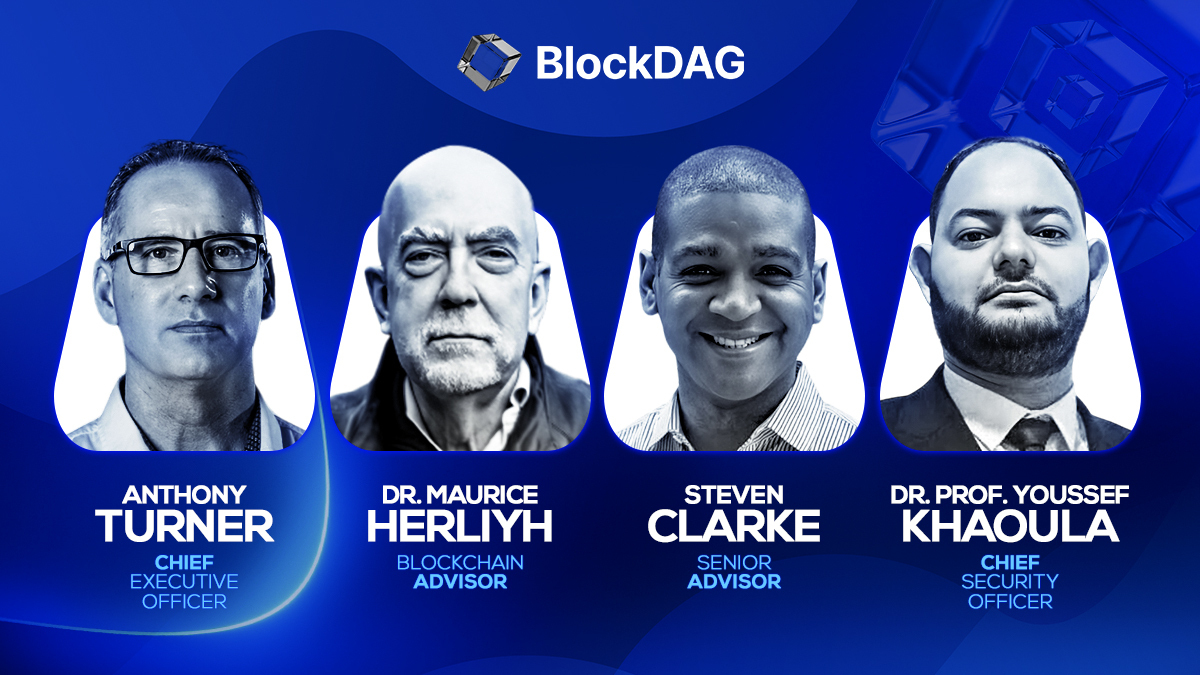
BlockDAG Network’s history is one of innovation, perseverance, and a vision to push the boundaries of blockchain technology. With Harvard alumni, tech moguls, and best-selling authors at the helm, BlockDAG is rewriting the rules of the cryptocurrency game.
CEO Antony Turner, inspired by the successes and shortcomings of Bitcoin and Ethereum, says, “BlockDAG leverages existing technology to push the boundaries of speed, security, and decentralization.” This powerhouse team has led a staggering 1,600% price increase in 20 pre-sale rounds, raising over $63.9 million. The secret? Unparalleled expertise and a bold vision for the future of blockchain.
Let’s dive into BlockDAG’s success story and find out what the future holds for this cryptocurrency.
The Origin: Why BlockDAG Was Created
In a recent interview, BlockDAG CEO Antony Turner perfectly summed up why the market needs BlockDAG’s ongoing revolution. He said:
“The creation of BlockDAG was inspired by Bitcoin and Ethereum, their successes and their shortcomings.
If you look at almost any new technology, it is very rare that the first movers remain at the forefront forever. Later incumbents have a huge advantage in entering a market where the need has been established and the technology is no longer cutting edge.
BlockDAG has done just that: our innovation is incorporating existing technology to provide a better solution, allowing us to push the boundaries of speed, security, and decentralization.”
The Present: How Far Has BlockDAG Come?
BlockDAG’s presale is setting new benchmarks in the cryptocurrency investment landscape. With a stunning 1600% price increase over 20 presale lots, it has already raised over $63.9 million in capital, having sold over 12.43 billion BDAG coins.
This impressive performance underscores the overwhelming confidence of investors in BlockDAG’s vision and leadership. The presale attracted over 20,000 individual investors, with the BlockDAG community growing exponentially by the hour.

These monumental milestones have been achieved thanks to the unparalleled skills, experience and expertise of BlockDAG’s management team:
Antony Turner – Chief Executive Officer
Antony Turner, CEO of BlockDAG, has over 20 years of experience in the Fintech, EdTech, Travel and Crypto industries. He has held senior roles at SPIRIT Blockchain Capital and co-founded Axona-Analytics and SwissOne. Antony excels in financial modeling, business management and scaling growth companies, with expertise in trading, software, IoT, blockchain and cryptocurrency.
Director of Communications
Youssef Khaoulaj, CSO of BlockDAG, is a Smart Contract Auditor, Metaverse Expert, and Red Team Hacker. He ensures system security and disaster preparedness, and advises senior management on security issues.
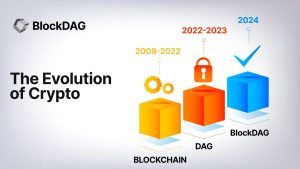
advisory Committee
Steven Clarke-Martin, a technologist and consultant, excels in enterprise technology, startups, and blockchain, with a focus on DAOs and smart contracts. Maurice Herlihy, a Harvard and MIT graduate, is an award-winning computer scientist at Brown University, with experience in distributed computing and consulting roles, most notably at Algorand.
The Future: Becoming the Cryptocurrency with the Highest Market Cap in the World
Given its impressive track record and a team of geniuses working tirelessly behind the scenes, BlockDAG is quickly approaching the $600 million pre-sale milestone. This crypto powerhouse will soon enter the top 30 cryptocurrencies by market cap.
Currently trading at $0.017 per coin, BlockDAG is expected to hit $1 million in the coming months, with the potential to hit $30 per coin by 2030. Early investors have already enjoyed a 1600% ROI by batch 21, fueling a huge amount of excitement around BlockDAG’s presale. The platform is seeing significant whale buying, and demand is so high that batch 21 is almost sold out. The upcoming batch is expected to drive prices even higher.

Invest in BlockDAG Pre-Sale Now:
Pre-sale: https://purchase.blockdag.network
Website: https://blockdag.network
Telegram: https://t.me/blockDAGnetwork
Discord: Italian: https://discord.gg/Q7BxghMVyu
No spam, no lies, just insights. You can unsubscribe at any time.
Tech
How Karak’s Latest Tech Integration Could Make Data Breaches Obsolete

- Space and Time uses zero-knowledge proofs to ensure secure and tamper-proof data processing for smart contracts and enterprises.
- The integration facilitates faster development and deployment of Distributed Secure Services (DSS) on the Karak platform.
Karak, a platform known for its strong security capabilities, is enhancing its Distributed Secure Services (DSS) by integrating Space and Time as a zero-knowledge (ZK) coprocessor. This move is intended to strengthen trustless operations across its network, especially in slashing and rewards mechanisms.
Space and Time is a verifiable processing layer that uses zero-knowledge proofs to ensure that computations on decentralized data warehouses are secure and untampered with. This system enables smart contracts, large language models (LLMs), and enterprises to process data without integrity concerns.
The integration with Karak will enable the platform to use Proof of SQL, a new ZK-proof approach developed by Space and Time, to confirm that SQL query results are accurate and have not been tampered with.
One of the key features of this integration is the enhancement of DSS on Karak. DSS are decentralized services that use re-staked assets to secure the various operations they provide, from simple utilities to complex marketplaces. The addition of Space and Time technology enables faster development and deployment of these services, especially by simplifying slashing logic, which is critical to maintaining security and trust in decentralized networks.
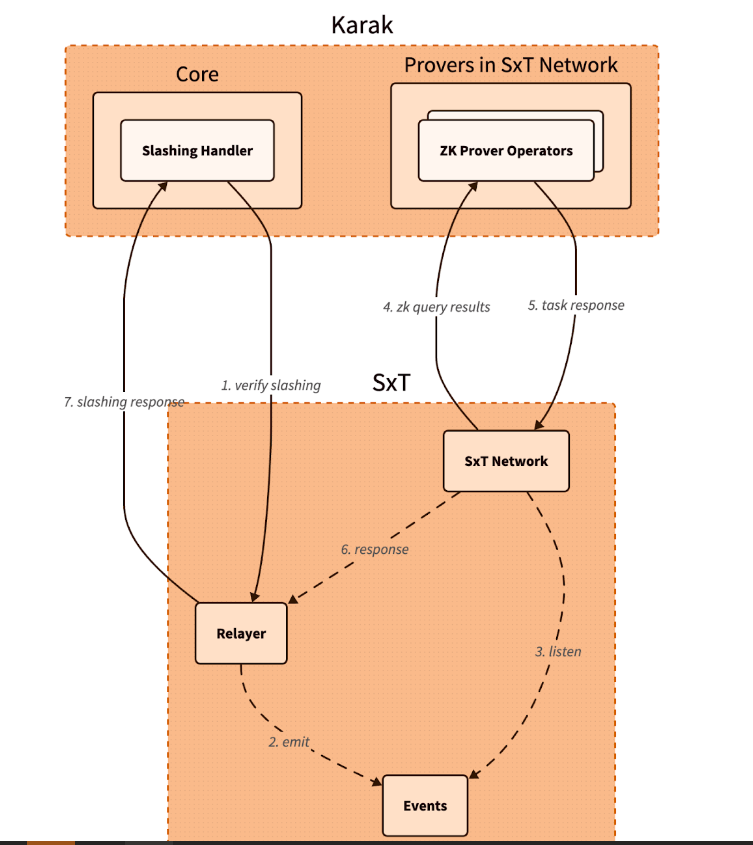
Additionally, Space and Time is developing its own DSS for blockchain data indexing. This service will allow community members to easily participate in the network by running indexing nodes. This is especially beneficial for applications that require high security and decentralization, such as decentralized data indexing.
The integration architecture follows a detailed and secure flow. When a Karak slashing contract needs to verify a SQL query, it calls the Space and Time relayer contract with the required SQL statement. This contract then emits an event with the query details, which is detected by operators in the Space and Time network.
These operators, responsible for indexing and monitoring DSS activities, validate the event and route the work to a verification operator who runs the query and generates the necessary ZK proof.
The result, along with a cryptographic commitment on the queried data, is sent to the relayer contract, which verifies and returns the data to the Karak cutter contract. This end-to-end process ensures that the data used in decision-making, such as determining penalties within the DSS, is accurate and reliable.
Karak’s mission is to provide universal security, but it also extends the capabilities of Space and Time to support multiple DSSs with their data indexing needs. As these technologies evolve, they are set to redefine the secure, decentralized computing landscape, making it more accessible and efficient for developers and enterprises alike. This integration represents a significant step towards a more secure and verifiable digital infrastructure in the blockchain space.
Website | X (Twitter) | Discord | Telegram
No spam, no lies, just insights. You can unsubscribe at any time.
Tech
Cryptocurrency Payments: Should CFOs Consider This Ferrari-Approved Trend?

Iconic Italian luxury carmaker Ferrari has announced the expansion of its cryptocurrency payment system to its European dealer network.
The move, which follows a successful launch in North America less than a year ago, raises a crucial question for CFOs across industries: Is it time to consider accepting cryptocurrency as a form of payment for your business?
Ferrari’s move isn’t an isolated one. It’s part of a broader trend of companies embracing digital assets. As of 2024, we’re seeing a growing number of companies, from tech giants to traditional retailers, accepting cryptocurrencies.
This change is determined by several factors:
- Growing mainstream adoption of cryptocurrencies
- Growing demand from tech-savvy and affluent consumers
- Potential for faster and cheaper international transactions
- Desire to project an innovative brand image
Ferrari’s approach is particularly noteworthy. They have partnered with BitPay, a leading cryptocurrency payment processor, to allow customers to purchase vehicles using Bitcoin, Ethereum, and USDC. This satisfies their tech-savvy and affluent customer base, many of whom have large digital asset holdings.
Navigating Opportunities and Challenges
Ferrari’s adoption of cryptocurrency payments illustrates several key opportunities for companies considering this move. First, it opens the door to new customer segments. By accepting cryptocurrency, Ferrari is targeting a younger, tech-savvy demographic—people who have embraced digital assets and see them as a legitimate form of value exchange. This strategy allows the company to connect with a new generation of affluent customers who may prefer to conduct high-value transactions in cryptocurrency.
Second, cryptocurrency adoption increases global reach. International payments, which can be complex and time-consuming with traditional methods, become significantly easier with cryptocurrency transactions. This can be especially beneficial for businesses that operate in multiple countries or deal with international customers, as it potentially reduces friction in cross-border transactions.
Third, accepting cryptocurrency positions a company as innovative and forward-thinking. In today’s fast-paced business environment, being seen as an early adopter of emerging technologies can significantly boost a brand’s image. Ferrari’s move sends a clear message that they are at the forefront of financial innovation, which can appeal to customers who value cutting-edge approaches.
Finally, there is the potential for cost savings. Traditional payment methods, especially for international transactions, often incur substantial fees. Cryptocurrency transactions, on the other hand, can offer lower transaction costs. For high-value purchases, such as luxury cars, these savings could be significant for both the business and the customer.
While the opportunities are enticing, accepting cryptocurrency payments also presents significant challenges that businesses must address. The most notable of these is volatility. Cryptocurrency values can fluctuate dramatically, sometimes within hours, posing potential risk to businesses that accept them as payment. Ferrari addressed this challenge by implementing a system that instantly converts cryptocurrency received into traditional fiat currencies, effectively mitigating the risk of value fluctuations.
Regulatory uncertainty is another major concern. The legal landscape surrounding cryptocurrencies is still evolving in many jurisdictions around the world. This lack of clear and consistent regulations can create compliance challenges for companies, especially those operating internationally. Companies must remain vigilant and adaptable as new laws and regulations emerge, which can be a resource-intensive process.
Implementation costs are also a significant obstacle. Integrating cryptocurrency payment systems often requires substantial investment in new technology infrastructure and extensive staff training. This can be especially challenging for small businesses or those with limited IT resources. The costs are not just financial; a significant investment of time is also required to ensure smooth implementation and operation.
Finally, security concerns loom large in the world of cryptocurrency transactions. While blockchain technology offers some security benefits, cryptocurrency transactions still require robust cybersecurity measures to protect against fraud, hacks, and other malicious activity. Businesses must invest in robust security protocols and stay up-to-date on the latest threats and protections, adding another layer of complexity and potential costs to accepting cryptocurrency payments.
Strategic Considerations for CFOs
If you’re thinking of following in Ferrari’s footsteps, here are the key factors to consider:
- Risk Assessment: Carefully evaluate potential risks to your business, including financial, regulatory, and reputational risks.
- Market Analysis: Evaluate whether your customer base is significantly interested in using cryptocurrencies for payments.
- Technology Infrastructure: Determine the costs and complexities of implementing a cryptographic payment system that integrates with existing financial processes.
- Regulatory Compliance: Ensure that cryptocurrency acceptance is in line with local regulations in all markets you operate in. Ferrari’s gradual rollout demonstrates the importance of this consideration.
- Financial Impact: Analyze how accepting cryptocurrency could impact your cash flow, accounting practices, and financial reporting.
- Partnership Evaluation: Consider partnering with established crypto payment processors to reduce risk and simplify implementation.
- Employee Training: Plan comprehensive training to ensure your team is equipped to handle cryptocurrency transactions and answer customer questions.
While Ferrari’s adoption of cryptocurrency payments is exciting, it’s important to consider this trend carefully.
A CFO’s decision to adopt cryptocurrency as a means of payment should be based on a thorough analysis of your company’s specific needs, risk tolerance, and strategic goals. Cryptocurrency payments may not be right for every business, but for some, they could provide a competitive advantage in an increasingly digital marketplace.
Remember that the landscape is rapidly evolving. Stay informed about regulatory changes, technological advancements, and changing consumer preferences. Whether you decide to accelerate your crypto engines now or wait in the pit, keeping this payment option on your radar is critical to navigating the future of business transactions.
Was this article helpful?
Yes No
Sign up to receive your daily business insights
Tech
Bitcoin Tumbles as Crypto Market Selloff Mirrors Tech Stocks’ Plunge
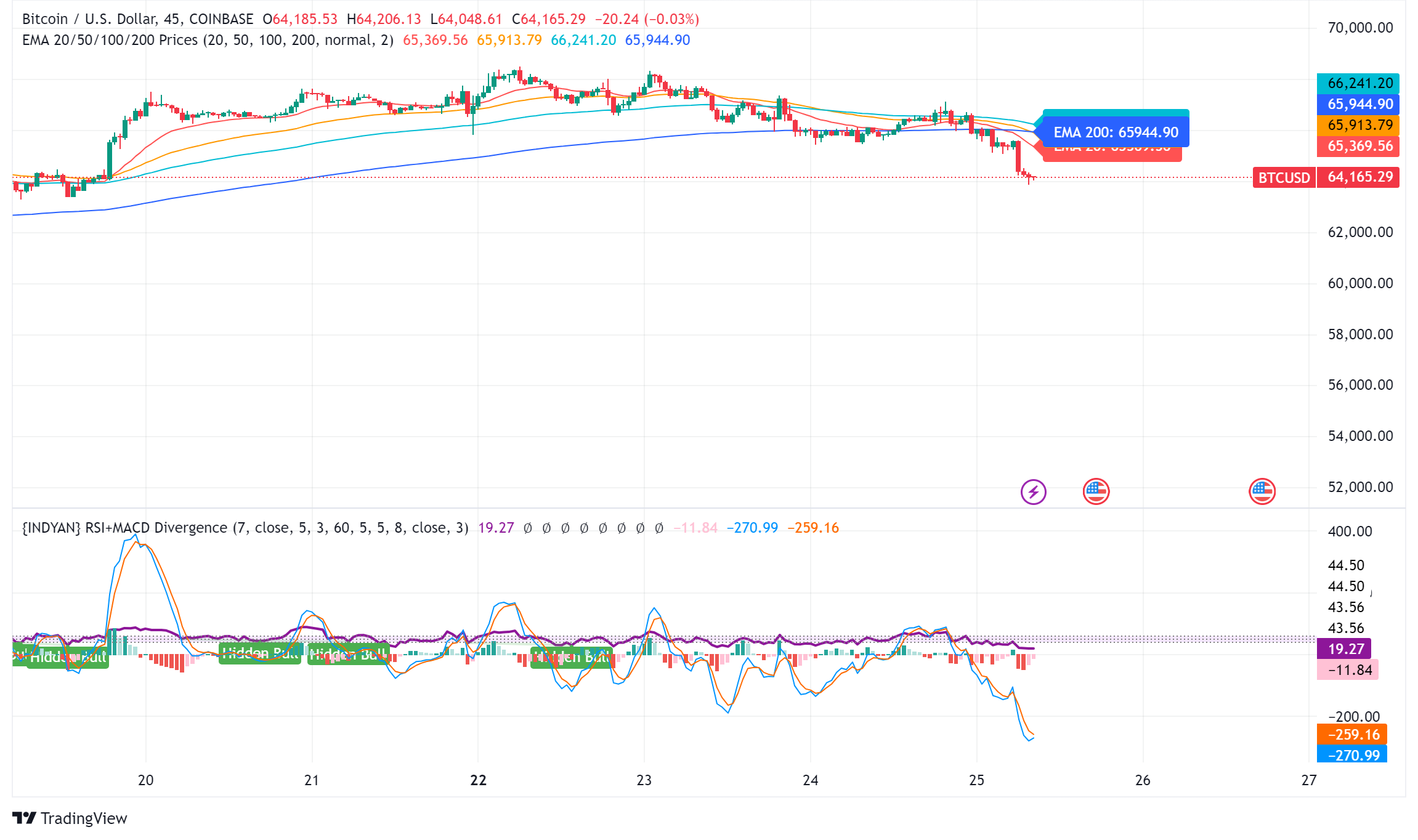
The world’s largest cryptocurrency, Bitcoin (BTC), suffered a significant price decline on Wednesday, falling below $65,000. The decline coincides with a broader market sell-off that has hit technology stocks hard.
Cryptocurrency Liquidations Hit Hard
CoinGlass data reveals a surge in long liquidations in the cryptocurrency market over the past 24 hours. These liquidations, totaling $220.7 million, represent forced selling of positions that had bet on price increases. Bitcoin itself accounted for $14.8 million in long liquidations.
Ethereum leads the decline
Ethereal (ETH), the second-largest cryptocurrency, has seen a steeper decline than Bitcoin, falling nearly 8% to trade around $3,177. This decline mirrors Bitcoin’s price action, suggesting a broader market correction.
Cryptocurrency market crash mirrors tech sector crash
The cryptocurrency market decline appears to be linked to the significant losses seen in the U.S. stock market on Wednesday. Stock market listing The index, heavily weighted toward technology stocks, posted its sharpest decline since October 2022, falling 3.65%.
Analysts cite multiple factors
Several factors may have contributed to the cryptocurrency market crash:
- Tech earnings are underwhelming: Earnings reports from tech giants like Alphabet are disappointing (Google(the parent company of), on Tuesday, triggered a sell-off in technology stocks with higher-than-expected capital expenditures that could have repercussions on the cryptocurrency market.
- Changing Political Landscape: The potential impact of the upcoming US elections and changes in Washington’s policy stance towards cryptocurrencies could influence investor sentiment.
- Ethereal ETF Hopes on the line: While bullish sentiment around a potential U.S. Ethereum ETF initially boosted the market, delays or rejections could dampen enthusiasm.
Analysts’ opinions differ
Despite the short-term losses, some analysts remain optimistic about Bitcoin’s long-term prospects. Singapore-based cryptocurrency trading firm QCP Capital believes Bitcoin could follow a similar trajectory to its post-ETF launch all-time high, with Ethereum potentially converging with its previous highs on sustained institutional interest.
Rich Dad Poor Dad Author’s Prediction
Robert Kiyosaki, author of the best-selling Rich Dad Poor Dad, predicts a potential surge in the price of Bitcoin if Donald Trump is re-elected as US president. He predicts a surge to $105,000 per coin by August 2025, fueled by a weaker dollar that is set to boost US exports.
BTC/USD Technical Outlook
Bitcoin price is currently trading below key support levels, including the $65,500 level and the 100 hourly moving average. A break below the $64,000 level could lead to further declines towards the $63,200 support zone. However, a recovery above the $65,500 level could trigger another increase in the coming sessions.
-

 News11 months ago
News11 months agoVolta Finance Limited – Director/PDMR Shareholding
-

 News11 months ago
News11 months agoModiv Industrial to release Q2 2024 financial results on August 6
-

 News11 months ago
News11 months agoApple to report third-quarter earnings as Wall Street eyes China sales
-

 News11 months ago
News11 months agoNumber of Americans filing for unemployment benefits hits highest level in a year
-

 News1 year ago
News1 year agoInventiva reports 2024 First Quarter Financial Information¹ and provides a corporate update
-

 News1 year ago
News1 year agoLeeds hospitals trust says finances are “critical” amid £110m deficit
-

 DeFi1 year ago
DeFi1 year ago🏴☠️ Pump.Fun operated by Insider Exploit
-

 Markets1 year ago
Markets1 year agoWhale Investments in Bitcoin Hit $100 Billion in 2024, Fueling Insane Investor Optimism ⋆ ZyCrypto
-

 Tech1 year ago
Tech1 year agoBitcoin’s Correlation With Tech Stocks Is At Its Highest Since August 2023: Bloomberg ⋆ ZyCrypto
-

 Tech1 year ago
Tech1 year agoEverything you need to know
-

 News11 months ago
News11 months agoStocks wobble as Fed delivers and Meta bounces
-

 Markets1 year ago
Markets1 year agoCrazy $3 Trillion XRP Market Cap Course Charted as Ripple CEO Calls XRP ETF “Inevitable” ⋆ ZyCrypto

